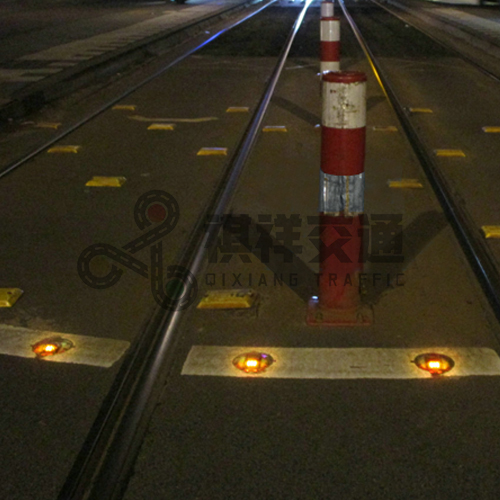Solar road studs have become a popular solution for improving road safety and visibility around the world. These small but efficient devices are primarily used to provide guidance and warnings to drivers, especially at night or in low-light conditions. Solar road studs are powered by solar energy and offer numerous advantages in terms of sustainability, cost-effectiveness, and improved road safety.
Solar road studs, also known as solar pavement markers or solar peepholes, are small devices that are embedded in the sidewalk or pavement. They are typically made from durable materials such as aluminum or polycarbonate and feature solar panels, LED lights, batteries, and other important components. These devices absorb sunlight through solar panels during the day and convert it into electricity to charge internal batteries.
The solar panels used in these studs are specially designed to effectively capture solar energy even in low-light conditions. Typically made from high-quality crystalline or amorphous silicon, they can generate electricity from both direct and diffuse sunlight. This ensures that the solar studs remain operational even on cloudy or rainy days with less direct sunlight.
The electricity generated by the solar panels is stored in batteries inside the solar studs. The battery acts as a container for storing energy to power the LED lights installed in the device. Known for their low power consumption and long life, LED lights are often used in solar road studs because they require less energy to produce bright illumination.
Solar road studs are often equipped with light-sensitive sensors that automatically activate the LED lights at dusk or when ambient light reaches a certain low level. This feature ensures that the studs only light up when needed, optimizing energy consumption and extending battery life.
At night or in low-light conditions, the LED lights in solar studs emit bright, highly visible light. This greatly improves visibility on the road, guiding drivers and ensuring safer navigation. The light emitted by solar road studs can be configured in different colors, such as white, red, green, or yellow, depending on the specific use and road requirements.
One of the significant advantages of solar studs is their self-sustainability. By harnessing renewable solar energy, these devices eliminate the need for external power sources and the associated costs and infrastructure. They can be easily installed in remote or off-grid areas without complex wiring or maintenance. Solar road studs provide a cost-effective and environmentally friendly solution for improving road safety and visibility.
Additionally, solar road studs have a long service life and require minimal maintenance. Durable construction and weatherproof design ensure its longevity even in harsh weather conditions such as heavy rain, snow, or extreme temperatures. The automatic activation and low power consumption of the LED lights further increase the lifespan and efficiency of solar road studs.
Solar road studs are widely used in various road safety measures. They are often used to mark lane divisions, highlight curves or dangerous areas, indicate crosswalks, and demarcate traffic lanes. These small but powerful devices significantly improve road safety by providing drivers with clearly visible guidance, especially in poor weather or low-light conditions.
To sum up, solar road studs are powered by solar energy through the use of solar panels, batteries, and LED lights. These efficient and sustainable devices offer a variety of benefits, including improved road safety, cost-effectiveness, and self-sustainability. By harnessing renewable solar energy, solar road studs help create safer roads and reduce accidents, making them increasingly popular for road infrastructure projects around the world.
If you are interested in solar road studs, welcome to contact Qixiang to get a quote.
Post time: Dec-01-2023







